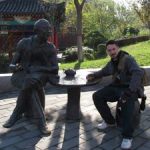- Ukrainian snipers rarely use ghillie suits, camouflage preferred by Western snipers, several marksmen told the Kyiv Post.
- They said they like rifles made by Canada, Finland, and the US, but not the old Soviet-developed SVD rifles.
- All three of the snipers were civilians before the war, and shooting was just a hobby.
Ukraine's snipers don't really use a key piece of gear commonly used by Western snipers to hide themselves on the battlefield, several marksmen told the Kyiv Post, but a few Western rifles are apparently among their go-to weapons.
On the front lines, the snipers deploy with a "whole golf bag" of rifles, they said, but they are leaving the big leafy camouflage outfits known as ghillie suits behind because they're much more of a hassle and can even risk getting a sniper killed.
Ghillie suits are outfits carefully crafted using jute, strips of cloth, and even actual vegetation and are common among snipers because they can help them blend into their environment and become invisible to the eyes of the enemy. For the US military, ghillie suit preparation is a key part of sniper training.
Concealment and camouflage are key skills for snipers as they gather battlefield intelligence, direct fires, and, when necessary, put a precision kill shot on target down range. A ghillie suit is not always necessary to achieve that though.

The snipers who talked about their experiences with the Kyiv Post's Stefan Korshak said that snipers in the Ukrainian armed forces rarely use ghillie suits because they are heavy, which can be somewhat less than ideal when they're hiking miles across the battlefield.
The relatively wet climate and mud-covered battlefields also tend to make them less effective when it comes to blending in, as it spoils the desired leafy effect, but a much bigger problem is what they mean to the operators of the drones constantly buzzing overhead.
The odd mixture of trenches and artillery battles and modern technology has led some observers to describe Ukraine's battlefields as being akin to World War I, but with drones, thousands of which are being used all along the front lines for reconnaissance and surveillance purposes.
Ukrainian marksmen don't much care for the ghillie suit because if a drone were to spot them while they were moving to a new position it would be instantly obvious what their mission is and make them a high-priority target.
There are other alternatives to the ghillie suit, they said, that are lighter and can be easily fitted with material that can improve the wearer's concealment against thermal sensors and night-vision systems, troubling threats to sniper operations.
But while they aren't fans of the ghillie suit, there's a few Western weapons they're fond of.

A Ukrainian sniper identified as Federchuk by the Kyiv Post said the Canadian-made Cadex Defence CX-33 TAC series rifle, .338 Lapua Magnum caliber, quickly became popular among snipers early in the war.
Other popular sniper weapons include the Finnish-made SAKO TRG and the US-made Barrett MRAD, both of which are used in .338 but also .308 as well. Unlike the heavy .50 caliber rifles more suitable for targeting vehicles, rifles in these calibers are preferred for engaging human targets.
A few years ago, the Barrett Multi-Role Adaptive Design (MRAD) rifle emerged as the weapon of choice for the US Army, Marines, and the special operations community. It's a multi-caliber rifle can be chambered in 7.62X51 mm NATO, .300 Norma Magnum, and .338 Norma Magnum, offering greater flexibility to the user. Of these, the .338 is the largest caliber and is often used by big-game hunters.
The weapons that were tossed aside when these Western weapons showed up were the Soviet/Russian-made SVD "Dragunov " sniper rifles.
The three men who spoke to the Kyiv Post were all civilians before the war, working good jobs in retail, auto parts, and camping equipment, and long-range shooting was a hobby.
But when Russia invaded in February 2022, they grabbed their rifles and helped defend Kyiv against Russian attempts to seize the capital. When the Russians fell back to positions in the east, the men were moved into a sniper unit, outfitted with high-end equipment like NATO sniper rifles and thermal sights, and sent to war, where all three have been wounded in combat.

